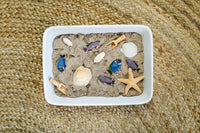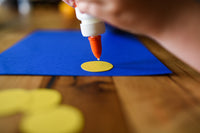You see them in classrooms and children’s museums, yet there’s no reason you can’t make a sensory bin for your child at home. They’re hands-on tools for children to explore their world through senses, or tactile learning. Children see how the corn moves, hear the way rice sounds when it pours, and touching all parts of the sensory bin. Perhaps children are smelling, too, if the bin has a scent, or even tasting if it’s safe to do so. Okay, yes, it can be messy, but sensory play is also fun, engaging, and open-ended, which means there is no defined outcome of playing with or exploring the materials inside the bin.
There are so many other benefits, too.
- Sensory bins teach what you might often hear called “life skills.” No, this is not doing laundry, but rather simpler skills we often take for granted like scooping, pouring, and dumping.
- While pouring rice into different containers, for instance, a child is learning skills useful for science and math: measurement (capacity), guesstimating, spatial awareness (the understanding of one object in relationship to another), and even learning about cause and effect.
- Sensory bin activities are child-driven, which helps them learn independence and increase focus.
- Sensory bins strengthen motor skills by manipulating small objects, pouring, and scooping.
- Children also learn social skills through sharing, playing, and communicating with others.

Make Your Own
Step 1. Select a bin. Clear storage containers work well so children can see inside. But you baking dishes, roasting pans, even a cardboard box will also work well.
Step 2. Select the filler. Favorites include rice, pasta shapes, water beads, water, sand, shells, dried beans, shredded paper, popcorn kernels – endless possibilities!
Step 3. Have cups, scoops, bowls, shovels, serving spoons, dump trucks, and/or ladles in the bin for scooping and dumping.
Step 4. Add objects. Don’t shy away from creating themes or learning concepts. Be mindful of what you’re putting into the bin, of course, avoiding possible choking hazards,
Themed Sensory Bins
It can be fun to just put interesting sensory items in a bin for play, but it can also be fun to create themes for creative play. (Parents need a creative outlet, too, right?) Here are a few ideas to get you started.
“Beach” – Try Kinetic Sand, seashells, fish figures.
“Ocean” – Don’t overlook water beads, seashells, ocean animal figures.
“Insects” – Green dyed rice, bug figures, magnifying glasses, and flowers work well. How to make colored rice?
“Colors” – Stick with 1-2 colors and gather pompoms, dried food, beads, small toy that match.
“Food” – Try dried pasta, colored rice, dried beans, dried peas, measuring cups and spoons.
Find out more of our favorite sensory bin themes.




